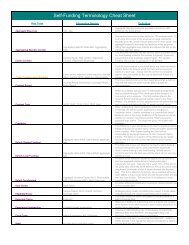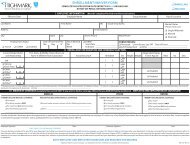Aetna Brochure - Steve Shorr Insurance
Aetna Brochure - Steve Shorr Insurance
Aetna Brochure - Steve Shorr Insurance
You also want an ePaper? Increase the reach of your titles
YUMPU automatically turns print PDFs into web optimized ePapers that Google loves.
Quality health plans & benefitsHealthier livingFinancial well-beingIntelligent solutionsUnderstanding how the Health InsurerFee and Transitional ReinsuranceContribution will impact youHealth care reform update for insured andself-funded health planswww.aetna.com90.03.139.1 (10/12)
Understanding the newindustry-wide fee andcontribution that impacthealth plansThe Affordable Care Act (ACA) includes a number of provisionsthat are expected to impact insured and self-funded healthbenefits and health insurance plans. As additional regulatoryguidance has become available we have shared informationwith you. In that spirit, this communication is focused on two ofthe four ACA-mandated taxes and fees that are expected todirectly impact health plans going forward.• Health Insurer Fee (HIF)• Transitional Reinsurance Contribution (RC)Because these new federal feeswill impact the cost of plansgoing forward, we feel it’simportant for you to understandthe fees. By doing so, you canbetter anticipate and plan forthe expected impacts.This flyer will help you understand:• What each fee is about• Which plans are impacted• How much is each fee andthe expected cost to plans• Who pays the fees• When we expect each feeto impact <strong>Aetna</strong> plans<strong>Aetna</strong> is the brand name used for products and services provided by one or more of the <strong>Aetna</strong> group of subsidiary companies, including <strong>Aetna</strong> Life<strong>Insurance</strong> Company and its affiliates (<strong>Aetna</strong>).2
Health Insurer FeeWhat is it?One key component of the Affordable Care Act (ACA) is tomake sure everyone has access to health insurance. As a result,an estimated 29 to 33 million people will enter the insurancemarket in 2014.Many of these new entrants are lower-income families andindividuals that may not have coverage today who will receivefederal subsidies toward the purchase of insurance. The ACAestablished the Health Insurer Fee (HIF) to help fund thesesubsidies. The HIF will be assessed on health insurers andpayable beginning in 2014.Which plans?HIF applies to most forms of health insuranceThis includes:How much is the HIF?The federal government will collect these amounts fromhealth insurers to pay for the subsidies• 2014: $8 billion• 2015 and 2016: $11.3 billion• 2017: $13.9 billion• 2018: $14.3 billion• Years after 2018: preceding year amount increased by therate of annualized premium growthUnder the current law, the fee has no expiration date.The Secretary of the Treasury, through the IRS, will determinethe amount of the fee due by each health insurer basedon net premiums written for U.S. health risks, and bill eachcarrier annually.• Insured new business and renewals• Grandfathered and non-grandfathered plansThe federal government will determine the amount to becollected, based on each insurer’s portion of total premiumsthat are impacted by the fee. We are waiting for details fromthe government about which premiums will be included inthe market share calculation used to determine each insurer’sshare of the fee. The table below represents our assumptionsof what is likely to be included in and excluded from the feecalculation, taking the statutory language into account.HIF includes*• Plans that cover U.S.** health risks including medical,dental and vision• Plans that cover U.S. citizens and U.S. residents• Plans that cover individuals located in the U.S.(only during the location period)• Federal Employee Health Benefit Plans (FEHBP)• Medicare Advantage and Medicare Part D• Medicaid riskHIF does not include*• Medicare Supplement• Disability and accident-only coverages• Long-term care• Coverage for specific diseases if offered as independentnon-coordinated benefits• Hospital indemnity/other fixed indemnity insurance• Self-insured business• Stop loss*Based on our assumption.**U.S. defined as U.S. states, D.C., Puerto Rico and the U.S. possessions.3
Here’s how independent analysts estimate the HIFResearch conducted by the National Federation of IndependentBusinesses (NFIB)* in November 2011 suggests that insurancepremiums will increase by 2 percent to 3 percent as a result ofthis fee.The former director of the Congressional Budget Office,Douglas Holtz-Eakin conducted a study in March 2011**suggesting premium increases of 2.4 percent to over 3 percent.A letter from the Joint Committee of Taxation to Arizona SenatorJon Kyl in June 2011***, premiums would decrease by 2.0 percentto 2.5 percent if this fee is repealed.A study**** published by Oliver Wyman in October of 2011found that the Health Insurer Fee will, when fully implemented,increase the average cost of family coverage by $530 in thesmall group market, and $550 in the large group market.Oliver Wyman estimated the impact to 2014 premiums as1.9 to 2.3 percent of premiums in fully insured markets, with thispercentage expected to increase over time.Your renewal package or planproposal will include detailsabout how much the fee willimpact your specific plans.Who pays?Health insurance issuers are responsible for paying the feeThe Secretary of the Treasury will determine the amount of thefee due by each health insurance issuer and bill each issuerannually. The total annual fee is allocated to each insurer basedon its share of aggregated impacted premiums and each insureris required to remit the payment to the Federal Government.The fee is not assessed on self-funded plans.When and how will the HIF impact Premiums?HIF will impact health insurance premiums as early asFebruary 2013Our 2014 assessment, which will be payable by no later thanSeptember 30, will be spread across customers whose policiesinclude coverage for some portion of calendar year 2014.This means we will start to include some provision for the HIF inthe rates of customers renewing in February 2013, since someof those customers’ annual premiums are for 2014 coverage.The extent to which premiums are impacted by the HIF dependson the fraction of the 12-month policy period that represents2014 coverage.Here’s when we intend to collect and pay our assessment of HIF.Q12013Q2Q3Q42014 2015Jan Feb Mar Apr May Jun Jul Aug Sep Oct Nov Dec2/1/2013 Renewal: Start collectionQ1Q2Q3Q4Insured1/2014HIF effective5/2014Expected reportof supplementaldata to government9/2014Pay HIF9/2015Pay HIF*Effects of the PPACA Health <strong>Insurance</strong> Premium Tax on Small Businesses and Their Employers. Michael J. Chow, NFIB Research Foundation, November 9, 2011.Available at: www.nfib.com/Portals/0/PDF/AllUsers/research/studies/ppaca/health-insurance-tax-study-nfib-2011-11.pdf.**Higher Costs and the Affordable Care Act: The Case of the Premium Tax. Douglas Holtz-Eakin, American Action Forum, March 9, 2011.Available at: http://americanactionforum.org/sites/default/files/Case%20of%20the%20Premium%20Tax.pdf.***A copy of the letter is available at: www.ahipcoverage.com/wp-content/uploads/2011/11/Premium-Tax-JCT-Letter-to-Kyl-060311-2.pdf.****Chris Carlson, FSA, MAAA. 2011. Estimated Premium Impacts of Annual Fees Assessed on Health <strong>Insurance</strong> Plans.Available at www.ahip.org/Issues/Premium-Tax.aspx.4
Transitional Reinsurance Contribution (RC)What is it?Under the Affordable Care Act (ACA), health insurance issuersand third-party administrators, on behalf of self-funded plansponsors, will make contributions to raise funds for transitionalnon-profit reinsurance entities that will help offset the costs ofhigh-risk individuals in the individual market.Which plans?This new contribution applies to insured andself-funded plans• Insured new business and renewals• Grandfathered and non-grandfathered plans• Self-funded group health plansRC includes*All major medical products:• Insured plans (policies written by U.S.** licensedinsurance companies)• Self-funded group health plans• Grandfathered plans• State and local government employee plans• Federal Employee Health Benefit Plans (FEHBP)RC does not include*• Medicare Advantage and Medicare Part D• Medicaid risk• State Children’s Health <strong>Insurance</strong> Program (SCHIP)• Medicare Supplement and similar group supplemental coverage• Stop loss• Excepted benefits:--Disability and accident-only coverages--Benefits offered separately: Limited-scope dental,limited-scope vision, long-term care--Specified disease/illness if offered as independent,non-coordinated benefits--Hospital indemnity/other fixed indemnity insurance*Based on our assumption.**U.S. defined as U.S. states, D.C., Puerto Rico and the U.S. possessions.5
How much?The contributions will be in effect from January 1, 2014,through December 31, 2016The Department of Health and Human Services (HHS) and/orstate governments plan to collect $25 billion in fees fromhealth insurers and third-party administrators, on behalf ofself-funded group health plans, over the three-year period2014 through 2016.• $12 billion in 2014• $8 billion in 2015• $5 billion in 2016In addition, states may set higher contribution rates in orderto collect further funding for high-risk individuals in that state.This would be in addition to the federal assessment.Your renewal package or planproposal will include details abouthow much the fee will impactyour specific plans.Here’s how independent analysts estimate the RC• Recent Crowell & Moring webinar* for the American BenefitsCouncil discussed a range of $61 to $105 per member, per year(PMPY) with emphasis on the lower end of the range.• Milliman recently published a report for the Society of Actuariesthat indicates an increased premium estimate of $73 to $78 permember per year (PMPY) for the Reinsurance Contribution.**The HHS determines each health insurer’sand self-funded group health plan’s contributionamount on a per-capita basisUnder final regulations adopted in March 2012, the contributionamount will be expressed as a per capita rate. At the time of thiswriting, we are expecting the fee to be expressed in per-memberterms, rather than per-employee terms. HHS will announce thenational contribution rate for 2014 in the annual HHS Notice ofBenefit and Payment Parameters.Insured plansInsurer contributions will be based on the national per capitacontribution rate.The fee applies to member months in 2014, but our premiumsare level throughout the policy year, which (except for policiesissued or renewed in January) spans two different calendar years.In order to collect the reinsurance contribution for all policiesthat cover 2014 risks, we need to begin building this fee into anypolicy year that includes coverage for 2014. That means the feewill be included in premiums for renewals and new businessbeginning February 1, 2013.Self-funded plansEach self-funded plan’s contribution will be based on thenational per capita contribution rate released by HHS multipliedby the self-funded plan’s lives subject to the contribution.The national and state per capita rates will be known well beforecustomers will need to fund the contribution.*Webinar was accessed on August 28, 2012, at: www.appwp.org/documents2012/perretta_p4p-reinsurance080712.pdf.**The Milliman/Society of Actuaries study is “Design and Implementation Considerations of ACA Risk Mitigation Programs”, Adrian Clark and James T. O’Connor,June 2012. Accessed at: www.soa.org/Files/Research/Projects/research-health-aca-risk-mitigation.pdf.6
Who pays?Health <strong>Insurance</strong> issuers for insured plans and self-fundedgroup health plans are responsible for the contributionThe Secretary of HHS will provide the method for determiningthe amount each health insurance issuer and self-funded grouphealth plan is required to contribute. Self-funded group healthplans are responsible for funding the contribution and third-partyadministrators may collect and remit the payment on behalfof the plan.When?RC will begin impacting some health plans as early asFebruary 2013We intend to collect and remit payments for this contributionas follows, subject to regulatory approval:• Insured: Our 2014 assessment will be spread across allcustomers whose policies include coverage for some portionof calendar year 2014. This means that we will start to includesome provision for the RC in the rates of insured customersrenewing in February 2013, since some of those customers’annual premiums are for 2014 coverage. The extent to whichpremiums are impacted by the RC depends on the fraction ofthe 12-month policy period that represents 2014 coverage.• Self-funded: Self-funded plans are responsible for fundingthe contribution and third-party administrators, such as <strong>Aetna</strong>,may collect and remit the payment on behalf of the plan.Beginning January 1, 2014, we intend to collect the contributionamount through a claim wire billing process and remitpayments annually.2013Q Q Q Q2014 2015Jan Feb Mar Apr May Jun Jul Aug Sep Oct Nov DecQ Q Q Q2/1/2013 Renewal: Start collection of RCSelf-funded Insured1/2013Receive HHSfinal ruling1/1/2014: Start collection of RC through claim wireor12/2014 or1/2015*Collection and payment continues through 2016 and ends 2017or12/2014 or1/2015*Collection and payment continues through 2016 and ends 2017*Payment to HHS may be submitted on December 2014 or January 2015.Note: In some states rates are subject to regulatory approval and therefore treatment of taxes and fees may not be finalized at this time.7
Find more information on our websiteVisit www.HealthReformConnection.com,where you can learn more about the ACA,its many requirements, and how <strong>Aetna</strong> ispreparing for the changes ahead.The website includes:• Detailed descriptions of many provisionsof the law including those that are alreadyin effect and that will take effect betweennow and 2018• Answers to the most common questionson the law and its requirements• Our vision for creating a sustainablehealth care systemWe hope you’ll find the informationon the site helpful.This information is not intended to be legal or tax advice and should not be construed as such. The intent is to provide information only. Consult with your legalcounsel and tax experts for legal and tax advice. If you have questions about <strong>Aetna</strong> health plans, contact your <strong>Aetna</strong> Account Representative.Health benefits and health insurance plans contain exclusions and limitations. Information in this document is believed to be accurate as of the publication date;however, it is subject to change. For more information about <strong>Aetna</strong> plans, visit www.aetna.com.www.aetna.com©2012 <strong>Aetna</strong> Inc.90.03.139.1 (10/12)


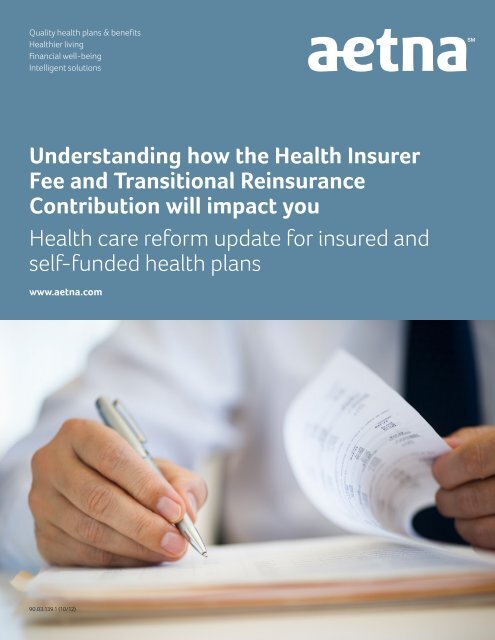
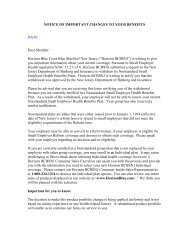
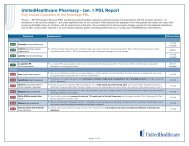
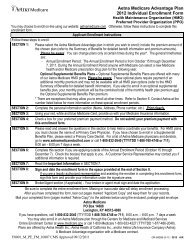
![[Letter Date] [First Name] [Last Name] [Street Address] [City, State ...](https://img.yumpu.com/49910635/1/190x245/letter-date-first-name-last-name-street-address-city-state-.jpg?quality=85)



